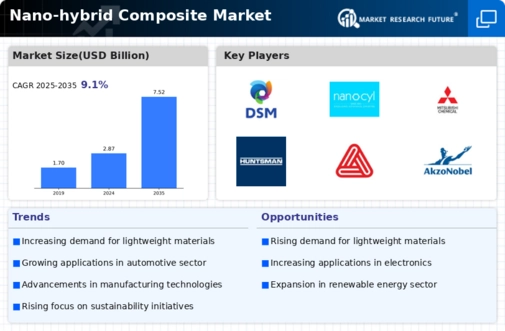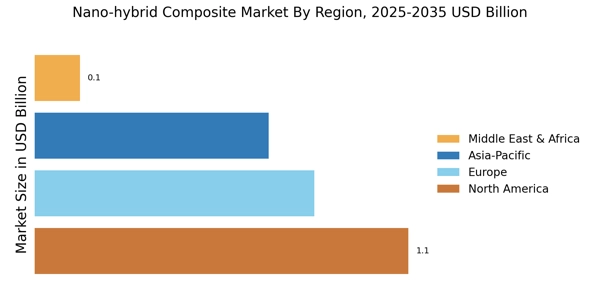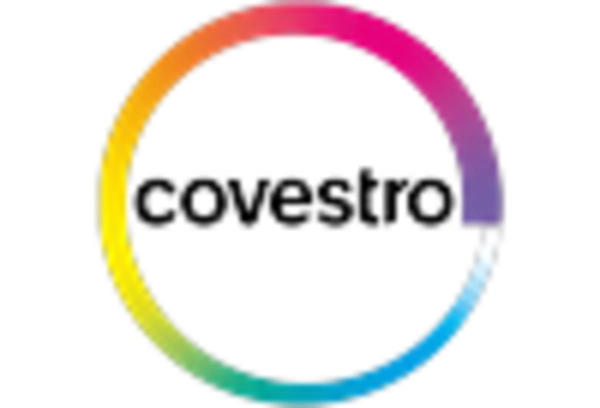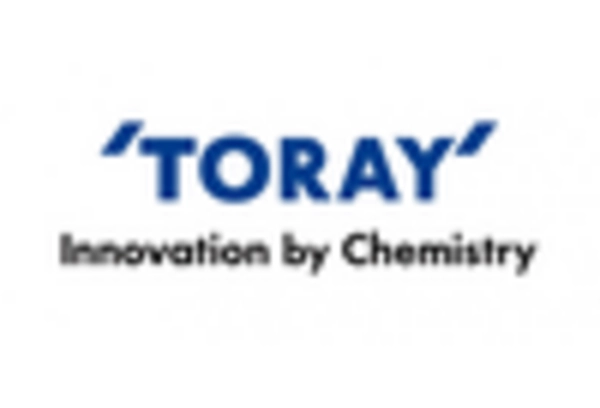Aerospace Applications
The aerospace sector's demand for advanced materials is a prominent driver for the Nano-hybrid Composite Market. With the need for lightweight yet robust materials to enhance fuel efficiency and performance, nano-hybrid composites are increasingly being utilized in aircraft manufacturing. These materials provide exceptional strength and resistance to extreme temperatures, making them suitable for critical aerospace applications. In 2025, the aerospace segment is anticipated to contribute significantly to the nano-hybrid composite market, with projections indicating a market value of around 8 billion USD. This growth is driven by the ongoing trend towards the development of next-generation aircraft that prioritize fuel efficiency and reduced environmental impact. As a result, the Nano-hybrid Composite Market is likely to see substantial advancements and opportunities within the aerospace domain.
Automotive Industry Growth
The automotive industry's growth is a vital driver for the Nano-hybrid Composite Market. As manufacturers strive to enhance vehicle performance and fuel efficiency, the adoption of lightweight materials has become increasingly critical. Nano-hybrid composites, known for their superior strength-to-weight ratio, are being integrated into various automotive components, including body panels and structural parts. In 2025, the automotive sector is projected to represent a significant portion of the nano-hybrid composite market, with estimates suggesting a market value exceeding 15 billion USD. This shift is further fueled by regulatory mandates aimed at reducing emissions and improving fuel economy. Consequently, the Nano-hybrid Composite Market is expected to benefit from the automotive sector's transition towards more sustainable and efficient materials.
Sustainability Initiatives
The increasing emphasis on sustainability initiatives is a pivotal driver for the Nano-hybrid Composite Market. As industries strive to reduce their carbon footprint, the demand for eco-friendly materials has surged. Nano-hybrid composites, which often incorporate renewable resources, align with these sustainability goals. For instance, the automotive sector is increasingly adopting these materials to enhance fuel efficiency and reduce emissions. In 2025, the market for sustainable composites is projected to reach approximately 30 billion USD, indicating a robust growth trajectory. This trend not only reflects consumer preferences but also regulatory pressures that encourage the use of sustainable materials. Consequently, the Nano-hybrid Composite Market is likely to experience significant growth as manufacturers seek to innovate and meet these evolving standards.
Technological Advancements
Technological advancements play a crucial role in propelling the Nano-hybrid Composite Market forward. Innovations in nanotechnology have enabled the development of composites with enhanced properties, such as improved strength, durability, and thermal resistance. For example, the integration of nanoparticles into traditional composite materials has shown to increase their mechanical performance significantly. In 2025, the market for advanced composite materials is expected to grow at a compound annual growth rate of around 12%, driven by these technological breakthroughs. Furthermore, the rise of smart materials that can respond to environmental changes is likely to create new applications for nano-hybrid composites. As industries continue to invest in research and development, the Nano-hybrid Composite Market is poised for substantial expansion, driven by these cutting-edge technologies.
Growing Demand in Electronics
The growing demand for lightweight and high-performance materials in the electronics sector is a significant driver for the Nano-hybrid Composite Market. As electronic devices become more compact and efficient, manufacturers are increasingly turning to nano-hybrid composites to meet these requirements. These materials offer excellent electrical insulation properties and thermal stability, making them ideal for applications in smartphones, laptops, and other consumer electronics. In 2025, the electronics segment is anticipated to account for a considerable share of the nano-hybrid composite market, with projections indicating a value of over 10 billion USD. This trend underscores the importance of innovation in material science, as companies seek to enhance product performance while reducing weight. Thus, the Nano-hybrid Composite Market is likely to thrive in response to the escalating demand from the electronics sector.


















Leave a Comment